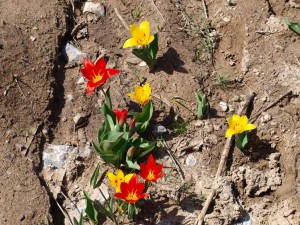23rd April 2013 Tashkent, Uzbekistan
Earth Day
 Yesterday, 22 April, was Earth Day – since 1970 a day of events around the world to “acknowledge the amazing planet we call home and take action to protect it”.
Yesterday, 22 April, was Earth Day – since 1970 a day of events around the world to “acknowledge the amazing planet we call home and take action to protect it”.
I spoke in the morning to students at the National University of Uzbekistan about the British government’s response, domestically and internationally, to the challenges of climate change. As always in my experience with university audiences here, they had lots of interesting questions and insights, and made me think hard about some of my own assumptions. I was presented with an Environmental Atlas of Uzbekistan to which specialists from the University contributed, a good example of the high quality work produced by academic institutions and specialist state organisations in this country. Earlier in the day I attended a seminar on Health and Safety organised by British mining company Rio Tinto, who at the end of last year received a license from the Government of Uzbekistan to explore for copper deposits. One of the senior speakers from Rio Tinto spoke of their goal in all their operations globally to do “zero harm” – to their workers’ health, to local communities and to the environment – and their aim to run their projects so that they have a net positive impact on biodiversity.
Over the last few weeks I’ve had a chance to see something of wild nature in Uzbekistan. Two weeks ago I visited the Emirates Bird Breeding Centre for Conservation near Bukhara. It’s a fascinating project to breed houbara bustards for hunting, but involving conservation experts from the University of East Anglia, with the aim of supporting a sustainable wild population of these extraordinary birds. I had the privilege of going out very early into the desert (at the moment a surprisingly green desert) to watch the male birds performing their courtship display, in which these otherwise plain-looking birds spread their neck feathers into an extravagant ruff and run in a figure of eight to attract the attention of female birds. Among houbara, it seems, it’s the female who chooses her mate, so the males have to work hard. It’s striking what a variety of life flourishes in what at first sight is an inhospitable environment – plants, birds, reptiles and insects and – shy to the point of invisibility – mammals too.
And yesterday I went into the mountains above Charvak to see the gorgeous wild tulips. It’s a fantastic sight, for someone who’s used to tulips as a domesticated garden flower, to see them growing wild on a high hillside. Both their size and the vividness of their colours are a surprise, and one can understand why Europe was gripped by tulip-mania in the 17th century. The flowers are short-lived, but they are a beautiful sign of spring, even as the higher peaks remain gloomy and snow-covered.